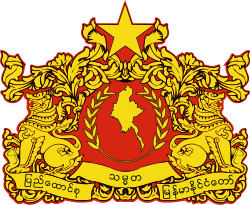Burmese general election, 1951–52
| | |||||||||||||||||||||||||||||||||
| |||||||||||||||||||||||||||||||||
| |||||||||||||||||||||||||||||||||
| |||||||||||||||||||||||||||||||||
 |
| This article is part of a series on the politics and government of Myanmar |
|
|
|
General elections were held in Burma over several months between June 1951 and April 1952 due to internal conflict within the country.[1][2]
The first elections since independence, they saw the Anti-Fascist People's Freedom League (AFPFL) win 60% of the vote and 199 out of 250 seats. Voter turnout was low at 20%, as only 1.5 million voters out of an eligible 8 million participated.[3] It was the lowest turnout for a Burmese election since the 1920s boycotts in colonial Burma.[1]
Results
| Party | Votes | % | Seats | +/– |
|---|---|---|---|---|
| Anti-Fascist People's Freedom League and allies[a] | 199 | +26 | ||
| People's Democratic Front[b] | 19 | New | ||
| Independent Arakanese Parliamentary Group | 6 | New | ||
| Greater Burma Party | 0 | New | ||
| People's Peace Front | 0 | New | ||
| Union of Burma League | 0 | New | ||
| United Chin Freedom League | 0 | New | ||
| Independents | 15 | |||
| Vacant | – | – | 11 | – |
| Invalid/blank votes | – | – | – | |
| Total | 1,500,000 | 100 | 250 | |
| Registered voters/turnout | 8,000,000 | 18.75 | – | – |
| Source: Nohlen et al. | ||||
a AFPFL allies included the Burma Socialist Party, the All-Burma Peasants Organisation, the Burma Muslim Congress, the Kachin National Congress (7 seats), the Union Karen League (13), the Chin Hills Congress, the United Hill People's Congress, the All-Burma Women's Freedom League and the All-Burma Federation of Trade Organisations, the Arakanese Muslim Association (3).[4][5]
b The People's Democratic Front was an alliance of the Burma Workers and Peasants Party (12 seats), the Patriotic Alliance and the Burma Democratic Party.[5]
References
- 1 2 Taylor, Robert H. (1996). The Politics of elections in Southeast Asia. Cambridge, UK: Cambridge University Press. p. 173. ISBN 978-0-521-56443-4.
- ↑ Hoffmann, Mark S (1954). World almanac and book of facts, Volume 69. Newspaper Enterprise Association. p. 338.
- ↑ Rotberg, Robert I (1998). Burma: prospects for a democratic future. Brookings Institution Press. p. 43. ISBN 978-0-8157-7581-2.
- ↑ Dieter Nohlen, Florian Grotz & Christof Hartmann (2001) Elections in Asia: A data handbook, Volume I, p614 ISBN 0-19-924958-X
- 1 2 Haruhiro Fukui (1985) Political parties of Asia and the Pacific, Greenwood Press, pp106–154

